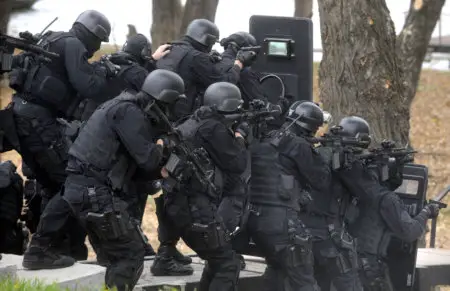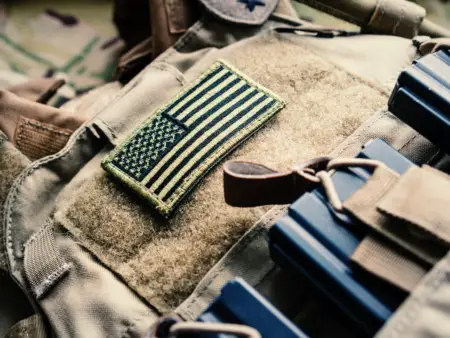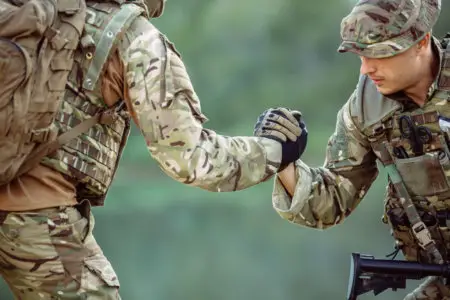Level IV Body Armor
When you’re depending on body armor to keep you alive, you should understand what it’s capable of!
What is level IV body armor? The National Institue of Justice (NIJ) says that level IV body armor will be able to stop a 166 gr .30 caliber Armor Piercing round at speeds of 2880 per second. Level IV armor and plate inserts tested with soft armor must be labeled as only providing level IV protection when paired together.
Level IV body armor takes a step up from level III body armor by adding more protection. It consists of hard armor or a combination of both hard and soft armor which makes it capable of providing protection from most rifle rounds used in warzones across the world.
[wc_toggle title=”Table of Contents” padding=”” border_width=”” class=”” layout=”box”]
- Level IV Body Armor
- What Does Level IV Body Armor Protect Against?
- What Is Level IV Body Armor Designed For?
- Does Level IV Body Armor Protect Against Anything Other than Bullets?
- How Does Level IV Body Armor Work?
- What Is Level IV Body Armor Made Of?
- Is Level IV Body Armor Legal?
- How do You Choose What Type of Armor you Should Buy?
- Related Questions
[/wc_toggle]
What Does Level IV Body Armor Protect Against?
The NIJ requires level IV armor to stop up to a .30 caliber Armor Piercing round moving 2880 ft/sec. This means that it is capable of stopping almost any rifle round out there short of extremely large caliber weapons.
Level IV armor is capable of defeating most rifle rounds .30 caliber and smaller.
.tg {border-collapse:collapse;border-spacing:0;border-color:#999;}
.tg td{font-family:Arial, sans-serif;font-size:14px;padding:10px 5px;border-style:solid;border-width:1px;overflow:hidden;word-break:normal;border-color:#999;color:#444;background-color:#F7FDFA;}
.tg th{font-family:Arial, sans-serif;font-size:14px;font-weight:normal;padding:10px 5px;border-style:solid;border-width:1px;overflow:hidden;word-break:normal;border-color:#999;color:#fff;background-color:#26ADE4;}
.tg .tg-s6z2{text-align:center}
| Body Armor Level | Effective Against These Calibers |
|---|---|
| III | .308 Winchester Full Metal Jacket = 7.62 X 51 mm NATO6 rounds at ~ 2,750 fps |
| IV | 30-06 Armor-Piercing .30 M2 AP One round at ~ 2,850 fps |
What Is Level IV Body Armor Designed For?
Level IV body armor hard armor that is designed to stop most common rifle calibers.
Level IV armor is worn in an external carrier since its usually worn by front line troops and special tactics teams from various agencies and police forces. Level IV armor can be carried in a backpack or briefcase but it’s usually much too heavy to make it worthwhile.
Most companies offering level IV body armor sell plates made from different types of materials and different capabilities. These include steel, composite materials, ceramic and ultra high molecular weight polyethylene (UHMWPE). Each comes with upsides and downsides that we’ll discuss later.
When you’re choosing body armor, you have to understand the threats that you’re most likely to encounter. With level IV body armor, you’re getting the most protection you can get. Level IV armor is typically worn by soldiers and police that need the most protection they can get regardless of the weight.

Does Level IV Body Armor Protect Against Anything Other than Bullets?
Level IV body armor isn’t specifically designed to protect against anything other than what it is tested against. It does, however, offer some protection against fragmentation from IEDs and other explosive devices as well as slashing and piercing weapons.
It’s just too think and hard for these weapons to have any effect on the wearer.
How Does Level IV Body Armor Work?
Just like level III body armor, level IV body armor functions in different ways depending on the materials that it’s constructed from.
Steel armor plates just shatter the bullet as it impacts the plate.
Ceramic level IV body armor plates are made with non-metallic materials that are very hard. These plates reduce the energy and penetrating ability of the bullet stop projectiles by deforming it as it passes through the ceramic material.
Ceramic plates are much more delicate than steel or UHMWPE armor plates. They also have poor multistrike performance. Manufacturers attempt to counter this by backing the ceramic plates with metal, or other ballistic materials.
UHMWPE plates are light, sheets of polymer and polymer strands compressed together to form dense plates. The polymer slows and deforms the bullet as it passes through the plate.

What Is Level IV Body Armor Made Of?
Manufacturers of steel level IV body armor use modern metallurgy techniques to create uniform and very dense steel plates for their armor. These steels ensure that the plate will react the same when it’s struck by a bullet no matter where it is hit.
Steel plates also usually have a spall resistant coating of some kind. This traps the bullet fragments from striking the wearer in their neck, head, hands, arms, legs, and feet. Many companies will offer different thicknesses of spall proofing depending on what you order.
Having a large slab of steel strapped to your chest can be uncomfortable at best. This is especially true for level IV body armor.
The non-metallic materials used in ceramic level IV body armor is extremely strong. Some of the most common materials used in making ceramic armor is boron carbide and other materials like it.
The manufacturing process and added ballistic material on ceramic plates make them more expensive than steel plates.
UHMWPE level IV armor is made with layers of polyurethane sheets and fibers pressed together under heat and high pressure. These plates are usually very thick compared to armor made from other materials. They are also extremely lightweight and can float.
UHMWPE armor does very well against multiple strikes and is more durable than ceramic plates. The downside is it should not be stored in high heat (like a car sitting in the sun) and can melt if it comes in contact with flames. The plates are also very thick and may not fit in every carrier.

Is Level IV Body Armor Legal?
This is where I need to give the obligatory disclaimer…I’m not a lawyer so only use this section as a guide. It is not legal advice.
Level IV Body Armor Legality in the United States: In the United States it is illegal to possess body armor if you are a convicted felon. In Connecticut, it is illegal to ship body armor meaning that all sales must be made face to face. Many other states have made it a felony to commit a violent crime while wearing body armor. Others have made it illegal to wear body armor on school grounds. Check your local laws to be sure!
There has been some talk among politicians in the U.S. about making body armor illegal.
Level IV Body Armor Legality in Canada: In Alberta, British Columbia, Manitoba, and Nova Scotia a license is required to possess body armor. In the remaining provinces, there are no restrictions.
Level IV Body Armor Legality in the UK: In the United Kingdom, there are currently no legal restrictions on the purchase and ownership of body armor.
Level IV Body Armor Legality in Australia: In Australia, it is illegal to possess body armor without proper authorization in South Australia, Victoria, Northern Territory, ACT, Queensland, and New South Wales.
[wc_box color=”primary” text_align=”left” margin_top=”” margin_bottom=”” class=””]
AR 500 Armor and Spartan Armor Systems both sell high-quality body armor of all types.
[/wc_box]
How do You Choose What Type of Armor you Should Buy?
When trying to determine what type of body armor you need, you should consider the following questions:
- Are you going to be facing pistol fire or rifle fire?
- Do you need knife or spike protection?
- Is it okay if others know that you’re wearing body armor?
With level IV body armor you need to take the advantages and disadvantages from each type of armor into consideration.
Level IV steel body armor is thinner than other types of armor plates, inexpensive, very durable and lasts the longest amount of time without needing to be replaced. The big downside is the weight!
Ceramic level IV body armor is light compared to steel armor and stops penetrating rounds very well. The downsides are the cost, poor multistrike performance and delicate nature of ceramic.
UHMWPE body armor is very light compared to other types of armor materials, has really good multistrike performance and can float if you happen to fall into the water. If you plan on being near water or on a boat while wearing your armor, you should seriously consider UHMWPE as an option. It does suffer from being much thicker (to the point that it can be difficult to get into a carrier), and it’s usually very expensive.
Related Questions
What is hard body armor? Level IV and hard body armor often refer to the same thing. When someone is discussing hard body armor they mean armor that doesn’t flex. Level III and IV body armors are considered hard body armor. Some level IIIa armor is made as hard body armor as well.
Does level IV body armor expire? The shelf life of body armor is going to depend on the materials used to make it. Steel body armor lasts 20 or more years with no maintenance. Ceramic and UHMWPE armor are typically said to have a 5-year shelf life.
The previous article Level IV Body Armor – High Velocity Protection was first published on: Ready Lifestyle Blog
